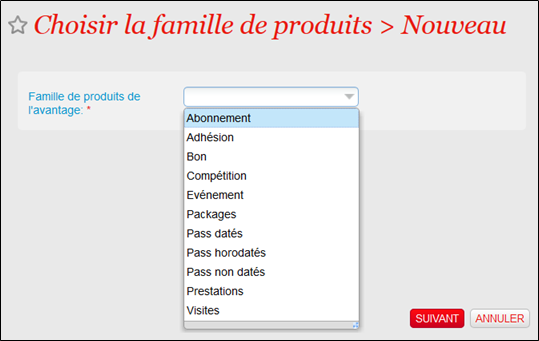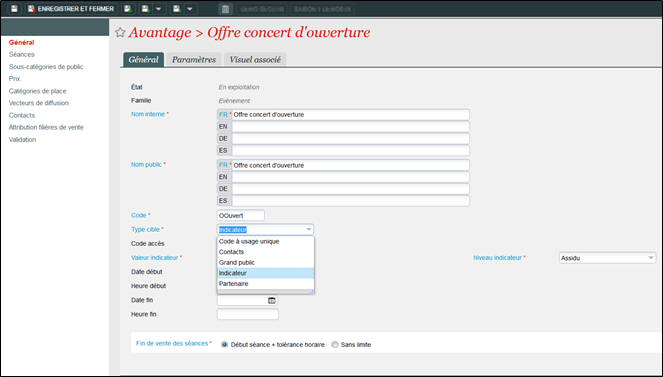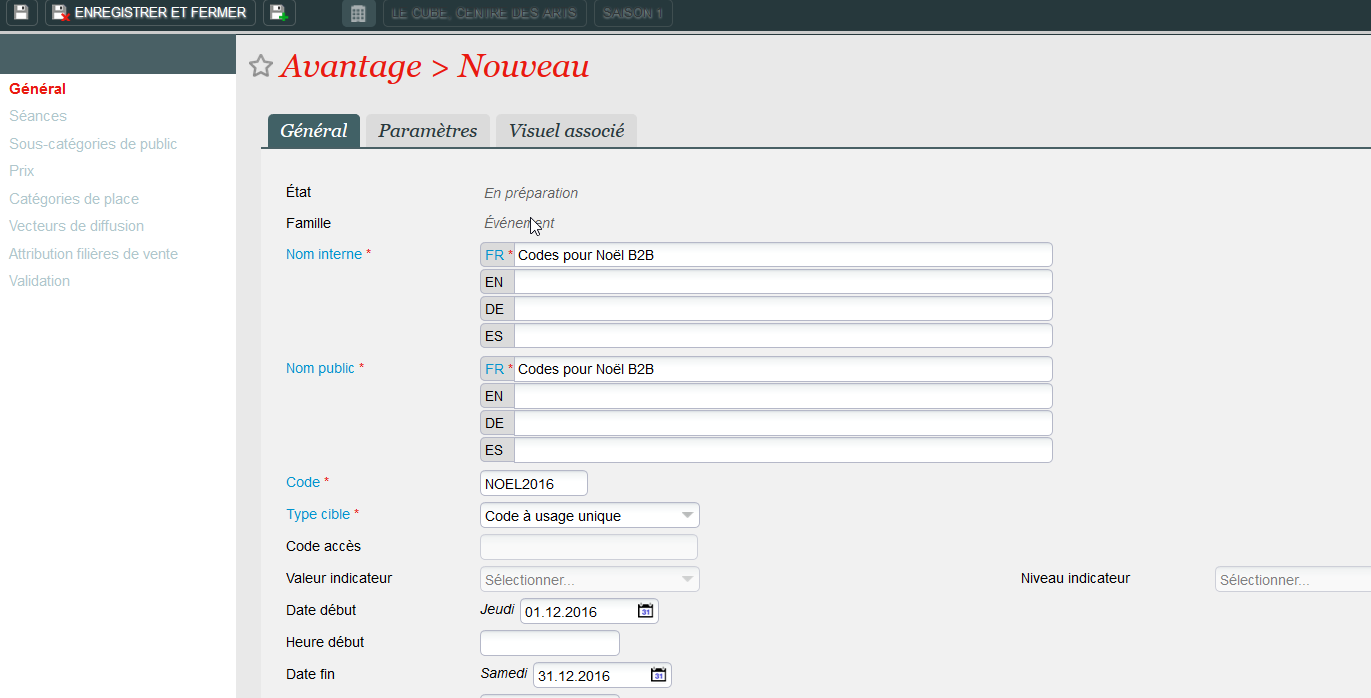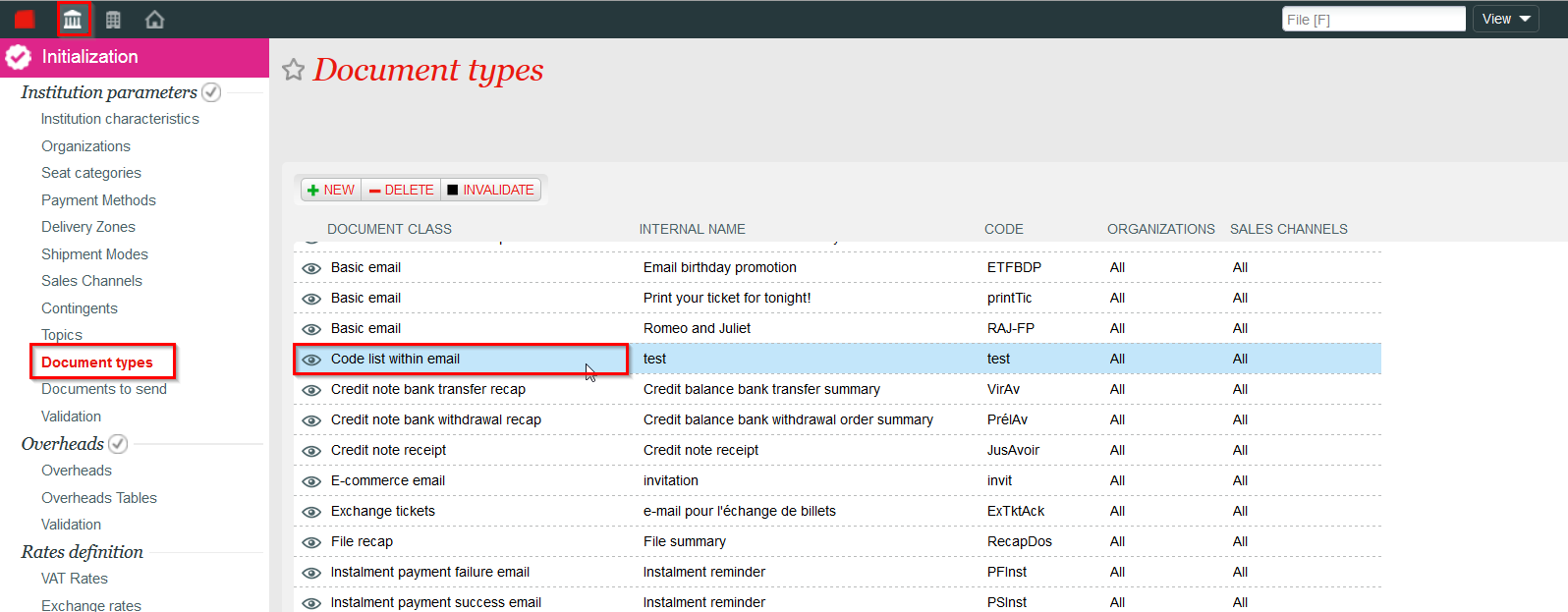Managing your sales strategy involves giving certain audiences advantages relating to certain products, under certain conditions.
SecuTix 360° allows you to issue different types of advantage according to the strategy that you wish to apply.
An advantage can be linked to one or several pre-set products and allows customers to access preferential prices under certain conditions, that you will have defined. An advantage is defined for a given season and linked to one, several or all internal sales channels. It can have a start date/time and an end date/time.
Advantages are differentiated within SecuTix 360° by the type of target that they’re aimed at:
Public
A general public advantage is one that anyone can benefit from, whether or not they are among your contacts. This is the case, for example, when you lower the price of one of your products, such as the official t-shirt for your 2013 festival, which you decide to sell for £15, rather than £25. Anyone may benefit from this offer.
Contacts
A contacts offer is an advantage given to named target contacts via a marketing campaign. Only a targeted contact can benefit from it, and they must be identified by the system in order to access it. There is therefore no code; a customer can benefit from it only by identifying themselves online or at the ticket office. This is the case, for example, when you launch an automatic campaign in the SAM aimed at people whose birthday it is: you congratulate them via email and tell them that to mark the occasion, you’re offering them 5% off tickets for the next event. By identifying themselves, these contacts can benefit from the discount.
Indicator
This type of advantage allows beneficiaries to be targeted according to the level of one of the indicators. For example, you might decide to offer a ticket at £30 instead of £45 for all contacts who have a “regular” attendance frequency. Therefore, once a contact’s “attendance frequency” indicator reaches “regular” thanks to the purchases that they’ve made, they will automatically be offered the reduced price of £30.
Partner
A partner advantage is actually a code that you configure and distribute. Anyone who knows the code can use it in the system and benefit from the advantage. This is the case, for example, when you publish an ad in a local newspaper featuring a code such as “CHRISTMAS2016”, giving everyone who uses it a discount.
Code for single use
Here, a set number of codes such as “XB56TR754” is generated en masse. These codes, once distributed, entitle recipients to an advantage. Each code may be used only once. You can, for example, use these codes on flyers to be distributed.
Le saviez-vous?
Promotional codes
A slightly maligned advantage, these allow you to grant either a percentage or a specific amount off a whole order. They differ from advantages because they are not linked directly to a specific product, but relate to a whole shopping cart. Note that if you are granting a specific amount off an order, you need to allow a corresponding payment method of type "Discount Voucher"
Conditions, such as a minimum total for the shopping cart or an indicator value, can be applied so as to limit the use of the code.
Settings
- You can create a new advantage from the Catalogue module
- The advantage can relate to any product family
- General information about the advantage:
- Choice of target type
- Identification of the quota
- Validity rule
- Choice of products and the audience sub-categories eligible for the advantage
- Selection of prices for each product concerned
- Designation of sales channels where the advantage may be used
- Validation and launch of the advantage
Single use codes
The settings for single use codes can be adjusted in the “Catalogue” module within the “Organisation” section of SecuTix and are applied through the “Additional sales” section of “Sales”. The general idea is that you first decide on the settings for the advantage, with its different properties, and on a quota (for example 350 codes), and you then distribute the codes through the “Additional sales” module. It’s up to you whether you distribute them directly or to B2B contacts. For example, you can send 100 single use codes to your Tourism Office B2B partner so that it can distribute them more widely.
Step 1 - Adjusting the advantage’s settings:
Note: this type of advantage will later require the creation of a document type (in “Institution”- “Code list within email” document type).
Step 2 - Code distribution
In “Sales”, you can distribute some of your codes to the contact of your choice via the “Generation and sending of codes” screen. An email will be sent with a list of codes. You can therefore send the codes either to yourself, or to a B2B partner for distribution.
Lastly, once your codes have been distributed, you can monitor how they’re being used via the dashboard located in the same menu.
Provision
Once advantages have been allocated to one or several sales channels and activated, the rules for displaying the different types are as follows:
- General Public advantages are available immediately for anyone making an order through SecuTix.
- Indicator advantages are available for all contacts with the required indicator level. Contacts who reach that level after the advantage has been launched may also benefit from it.
- Partner advantages are available for anyone with the set code.
- Contacts advantages are available to all contacts within the target of the campaign linked to the advantage. They can be accessed once the campaign has been activated in the SAM module.
- Single use codes are available to anyone who has received one of the codes on the list.









